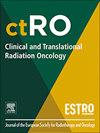Concurrent chemoradiotherapy versus radiotherapy alone in postoperative high-risk adenoid cystic carcinoma of the head and neck: A propensity score matched analysis
IF 2.7
3区 医学
Q3 ONCOLOGY
引用次数: 0
Abstract
Background
The role of concurrent chemoradiotherapy (CCRT) in postoperative head and neck adenoid cystic carcinoma (ACC) remains controversial due to the limited evidence from randomized trials. This study assessed the effectiveness of CCRT by comparing a prospective CCRT group with a retrospective radiation(RT) alone group using propensity score matching (PSM).
Methods and materials
Postoperative head and neck ACC patients with T3-4/N1-3 M0 disease or after R1/R2 resection were enrolled. All patients underwent intensity-modulated radiation therapy (IMRT), and CCRT group received two cycles of concurrent docetaxel and nedaplatin. To ensure comparability, PSM were utilized. Following PSM, survival outcomes were analyzed using Kaplan-Meier curves and compared using the log-rank test.
Results
A prospective CCRT group of 55 patients and a retrospective RT alone group of 160 patients were included. The multivariate Cox regression analysis showed no association between CCRT and overall survival (OS) (hazard ratio [HR] = 0.71, 95 %CI: 0.24–2.08, p = 0.537), or other survival outcomes. To mitigate potential confounding factors, a 1: 1 PSM analysis was performed. With a median follow-up of 51 months, post-PSM analysis (including 48 patients in each group) indicated no significant differences in OS (estimated 5-year OS rates: 90.7 % versus 84.3 %, p = 0.331), locoregional recurrence-free survival (LRRFS) (p = 0.261), distant metastasis-free survival (DMFS) (p = 0.425), or disease-free survival (DFS) (p = 0.600) between two groups. The multivariate Cox regression analysis also showed no association between CCRT and OS (HR = 0.29, 95 %CI: 0.06–1.38, p = 0.119), or other survival outcomes.
Conclusion
The addition of concurrent chemotherapy to postoperative IMRT did not confer a survival benefit in terms of LRRFS, DMFS, DFS, or OS in patients with head and neck ACC. Upcoming results from randomized studies are anticipated to shed more light on this debated issue. CCRT should be avoided outside of clinical trials.
术后高危头颈部腺样囊性癌同步放化疗与单独放疗:倾向评分匹配分析
背景:由于随机试验的证据有限,同步放化疗(CCRT)在头颈部腺样囊性癌(ACC)术后的作用仍然存在争议。本研究通过使用倾向评分匹配(PSM)将前瞻性CCRT组与回顾性放射(RT)单独组进行比较,以评估CCRT的有效性。方法和材料采用头颈部ACC术后合并T3-4/N1-3 M0病变或R1/R2切除患者。所有患者均接受调强放疗(IMRT), CCRT组同时接受多西紫杉醇和奈达铂两个周期。为了确保可比性,我们使用了PSM。PSM后,生存结果用Kaplan-Meier曲线进行分析,并用log-rank检验进行比较。结果纳入前瞻性CCRT组55例,回顾性单纯放疗组160例。多因素Cox回归分析显示,CCRT与总生存率(OS)(风险比[HR] = 0.71, 95% CI: 0.24-2.08, p = 0.537)或其他生存结局无关联。为了减少潜在的混杂因素,进行了1:1的PSM分析。中位随访时间为51个月,psm后分析(包括每组48例患者)显示,两组之间的OS(估计5年OS率:90.7% vs 84.3%, p = 0.331)、局部区域无复发生存率(LRRFS) (p = 0.261)、远端无转移生存率(DMFS) (p = 0.425)或无病生存率(DFS) (p = 0.600)无显著差异。多变量Cox回归分析也显示CCRT与OS (HR = 0.29, 95% CI: 0.06-1.38, p = 0.119)或其他生存结局无关联。结论:在头颈部ACC患者的LRRFS、DMFS、DFS或OS方面,在术后IMRT中加入同步化疗并没有带来生存获益。即将到来的随机研究结果预计将为这个有争议的问题提供更多的线索。在临床试验之外应避免使用CCRT。
本文章由计算机程序翻译,如有差异,请以英文原文为准。
求助全文
约1分钟内获得全文
求助全文
来源期刊

Clinical and Translational Radiation Oncology
Medicine-Radiology, Nuclear Medicine and Imaging
CiteScore
5.30
自引率
3.20%
发文量
114
审稿时长
40 days
 求助内容:
求助内容: 应助结果提醒方式:
应助结果提醒方式:


